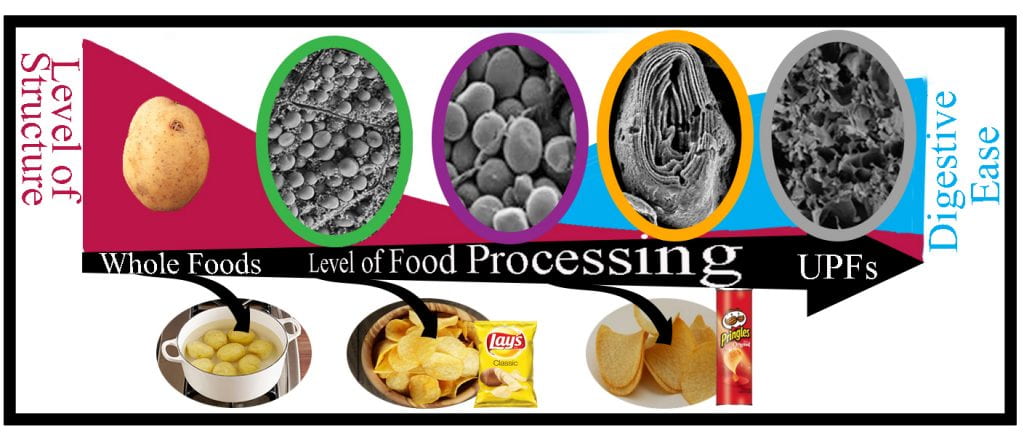
Funding for Dr. Rogers Laboratory has been Generously Provided from the Following Agencies:

Why Does Our Research Matter?
“Dis-moi ce que tu manges, je te dirai ce que tu es”
“Tell me what you eat and I will tell you what you are”
Anthlme Brillat-Savarin, 1826.


Foods Post-Industrial Revolution
For the past 250 or so years the industrialization of foods has focused on disruptive processes (i.e., cooking, size reduction, isolation and purification), creating a plethora of new self-stable, highly-functional, low-cost, convenient ingredients that are isolated from whole animal and plant cells to make starches, isolates, proteins, fats and oils, which are then recombined into UPFs. It is imaginable that within our lifetime, the processing of food will have a zero-waste footprint-a remarkable accomplishment. ‘Unfunctional’ waste products (peels, pits, stalks, husks, insects, larva, algae, etc.) will be refined through a series of physical, chemical, and enzyme disintegration unit operations, that are increasing exponentially in power and efficiency where the limits of refinement are pushed to the nano and molecular scale! Valorization of food waste streams will decrease our carbon footprint and improve food security while these technologies will turn waste streams and their associated financial and carbon costs, into cheap, highly-functional, ‘value-add’ ingredients. UPF will flood emerging markets with a smorgasbord of canned, bagged or boxed, INEXPENSIVE STAPLE foods. As relative cost between UPFs and minimally-processed foods decrease, their global relevance will rise preventing millions from following their own Food Guides (USDA’s ChooseMyPlate, Canadian, and EAT-Lancet Commission).
The current reality is the staple food for Western society is now Ultra-Processed Foods (UPFs) (>50% of one’s calories); but make no mistake about it, dietary patterns based on meals and dishes prepared from whole or minimally-processed foods, are being displaced by UPFs – GLOBALLY. For throughout all of human evolution, never have such rapid, pronounced modifications to foods/diets been observed. A discourse in diet this significant has not been witnessed since the onset of bipedalism, when Neanderthals ventured from forests in search of new food sources in response to changing climates. Only time will tell if changes imparted by the introduction of UPFs represent a significant enough environmental discourse to drive evolutionary adaptations; but it is becoming more and more clear that chronic life-time exposure to UPFs (e.g. Do you get more calories from UPFs than whole foods over a lifetime compared to whole foods) is becoming a major determinate of life-expectancy.

Appelhans (2009) provides a fascinating review on neurobehavioral inhibition of reward-driven feeding; where she provides an evolutionary context for why traditional hunter-gather diets evolved to preferentially over consume sweet and high-fat palatable foods. Hunter-gatherers, faced with limited supply of highly-palatable foods (e.g. fruit and animal meat), would have spent prolonged times foraging and hunting and the capacity to find these foods pleasurable motivated ancestral humans to engage in these food-seeking behavior. For most of human evolution, hominids were under constant risk of famine and satiety signals were overridden, facilitating over consumption of calories to be stored as fat—an effective buffer against starvation giving rise to hedonic feeding (i.e., our drive to eat to attain pleasure). Remarkably understudied, no clear understanding on how changing food structure, via food processing, effects digestion, satiety and hedonic feeding behavior. We know many factor effect our suppression of hunger and return of appetite; and, that our biological drive to eat has been highly tuned over the years responding in environments devoid of calories. Your regulation of the amount and ultimately choice of foods consumes is controlled by the gut-brain axis, a complex web of hedonic and biological factors including neural, immune, and endocrine systems as well as the gut microflora.

What Does This Mean to Canadians?
Simply put, the landscape of foods today is confusing. It is unrealistic to presume consumers attitudes, preference and ultimately choice are informed, considering the breadth and vastness of knowledge and ability to assess risk required to be well-informed on topics on food and nutrition (e.g. ultra-processed foods (UPF), genetically modified, sustainable, organic, local and fair trade, additives, probiotics, natural health products, nutraceuticals and supplements, nanotechnology, trans and saturated fats, artificial dyes, security, zoonoses, safety, obesity, artificial sweetness, keto- and paleo diets, and the gut microbiome to illustrate just a handful of examples). It truly boggles the mind. This is confounded with shifting messaging, around the healthfulness of even whole foods (i.e., dairy, meat, eggs, etc.) especially considering WHOs’ decision to classify red meat as a potential carcinogen. Today it is apparent that Western diets, which rely worryingly on ultra-processed foods, are the leading cause, along with our sedentary lifestyles, of obesity and chronic diseases such as metabolic syndrome (MetS), cardiovascular diseases, cancer, and numerous dysbiosis states of impaired gut microbiota.
Disturbingly, UFPs, the staple of Western diets (57.9% and 47.7% of the US and Canadian global food supply, respectfully), are making inroads globally, in all socio-economic populations as evidenced by their increased market share in both developed and developing nations. Diets consumed during the past few generations have led to the development of an entirely new epidemic, unheard of less than a century prior. Irrespective of the study origin countless populations have at least double-digit percentages of people with metabolic syndrome (MetS); where obesity is fundamental to MetS, as it precedes the emergence of impaired insulin sensitivity, dyslipidemia, hypertension and a 1.6-fold increase in mortality. This has sparked the UN General Assembly to declare that 2016 to 2025 would be the Decade of Nutrition because of worsening threats to food systems and supplies. At the same time, FAO recognized a disturbing trend of “displacement of dietary patterns based on meals and dishes prepared from unprocessed or minimally processed foods by those that are increasingly based on ultra-processed food”.
The long-term consequences of UFP consumption are well established; there are detrimental correlations between obesity (e.g., BMI, waist circumference, etc.) and non-communicable diseases, including heart disease and stroke, as well as cancers). All-cause mortality rates increase with increasing BMI. These changes have resulted in, for the first time, non-communicable diet-related diseases being responsible for a larger percentage (46.8 %) of the mortality rate than the communicable disease (41.0 %). This led global health authorities to shift attention from germs to what United Nations Secretary-General Ban Ki-moon calls “a public health emergency in slow motion”. Perhaps, what is even more shocking is that non-communicable diseases are responsible for nearly 2/3rds of deaths in the Americas and consumers are oblivious to the cause. Although no UFP individually is to blame for this disturbing trend, the normalization of UFP and widespread displacement of meals prepared from whole foods continues to exacerbate diet-related ailments of Canadians. Rhetoric often provides a misguided perception of wholesomeness.
Remember you are What You Eat!
Obesity rates are skyrocketing worldwide; obesogenic food environments (or food swamps) put vulnerable populations at greater risk, as evidenced by their differential access to food resources. Meanwhile, market shares of UPFs in developing nations are rising at alarming rates, and as UPFs are introduced they quickly saturate traditional food environments. Scientists around the world are trying to understand why obesity, especially in adolescents and children, is so prevalent; and most researchers are focused on macronutrient composition, specifically sugar, fat, & proteins and caloric intake. Michael Pollen, in 2008, stated “foods are not merely the sum of their parts”. Thus, it reasonable to postulate that nutritive importance or gain from the meticulously-built hierarchical structures found in whole foods has predicated our evolutionary path. These structures are assembled molecule-by-molecule, coerced by nature at enormous metabolic expense to protect macronutrients from deterioration, and humans have co-evolved consuming non-processed foods since the beginning of time. The question remains, how does food structure mitigate kinetics of digestion.

Our Research Aim is Simple
To expand knowledge on how UPFs differ from whole foods on influencing the satiety cascade and metabolic responses. This will position us to leverage global resources to ensure that next generation ultra-processed foods meet global and individual dietary needs.
:60 Second Snapshot-Profs of the OAC
Dr. Rogers appears on the Why & How Podcast discussing ultraprocessed foods.


